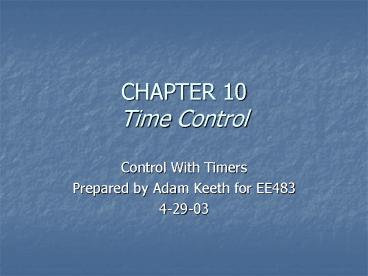CHAPTER 10 Time Control PowerPoint PPT Presentation
1 / 11
Title: CHAPTER 10 Time Control
1
CHAPTER 10Time Control
- Control With Timers
- Prepared by Adam Keeth for EE483
- 4-29-03
2
When Should One Use a Timer?
- Major function is to place information about
elapsed time into a control circuit. - Timers are not always the best way to control a
circuit - Overshoot/Undershoot example
- Critical criteria (time, pressure, temperature,
or position)
3
Timers and Time-Delay Relays
- Time Delay Relays
- Devices having a timing function after a timer
coil has been energized. Then either NO or NC
contacts activate. The only time function is the
preset time. - Timers ( Much more versatile)
- The time function may start on one or many
contacts at energizing, or at a preset time after
energizing.
4
The Timer (continued)
- The timer opens or closes electrical circuits to
selected operations according to a timed program. - Timing function begins when the timer receives an
electrical signal initiated through a manual
switch or automatic sensor. - Preset time is user-defined.
5
Types of Timers
- 2 Primary Types
- Synchronous Motor Driven
- Solid-State Type
- Other Types
- Dashpot
- Mechanical
- Electrochemical
- Thermal
- Timing Functions
- ON delay
- Timing function after energizing.
- OFF delay
- Timing function after deenergizing.
6
Synchronous Motor Driven Timer
- Very Common in Industrial Applications
- Available in three types
- Reset type
- Repeat-cycle type
- Manual-set type
- Symbols
7
Reset Timers
- Use a clutch and a synchronous motor. Most reset
timers have 3 contacts to provide output to the
electrical circuit. Each contact has three
conditions - Reset clutch and motor deenergized.
- Timing clutch energized.
- Timed Out motor deenergized.
- Sequence Chart Figure 10-5
8
Repeat Cycle Timers
- This type of timer is used to control several
electrical circuits in a predetermined sequence. - Adjustable cams on the motor shaft determine the
point of closing and opening a switch during a
revolution. In many cases, these cams are
screwdriver-adjustable. - Activation time and duration time are adjustable.
- Most include external calibrated discs to observe
the progress of the timer (Figure 10-9).
9
Manual-Set Timers
- This type requires manual operation to activate
the timer. - Timer runs and stops after a selected time.
- Figure 10-10AB
10
Solid State Timers
- Microprocessor-type timers are the most versatile
timers available. - Many incorporate keypad input and digital/LCD
readout. - Very accurate
- 100 accurate for count operations.
- Within 50 ms (or 0.5) accurate for timing
operations. - Can retain data for many years.
- Most are repeat-cycle capable.
11
(No Transcript)

